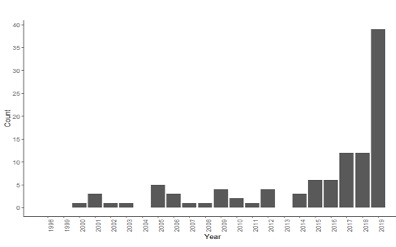Increasing Utilization of Anonymous Nondirected Living Liver Donors in the United States
1Keck School of Medicine of USC, Los Angeles, CA, 2University of Southern California, Los Angeles, CA, 3Surgery, University of Southern California, Los Angeles, CA
Meeting: 2020 American Transplant Congress
Abstract number: LB-009
Keywords: Liver transplantation, Living donor
Session Information
Session Name: Poster Session A: Late Breaking
Session Type: Poster Session
Date: Saturday, May 30, 2020
Session Time: 3:15pm-4:00pm
 Presentation Time: 3:30pm-4:00pm
Presentation Time: 3:30pm-4:00pm
Location: Virtual
*Purpose: Recently, there has been growth in the rate of living donor liver transplantation in the U.S. Increasingly, liver transplant programs are evaluating potential anonymous or ‘altruistic’ nondirected living liver donors (NLLDs). The purpose of this study was to review the Scientific Registry of Transplant Recipients to characterize the NLLD patient population and trends of NLLD utilization in the U.S.
*Methods: The Scientific Registry of Transplant Recipients (SRTR) was reviewed from 1/1/1998-12/31/2019 to identify NLLD. Patient demographics and recipient outcomes were reviewed.
*Results: In the study period, 105 NLLDs were identified. The first NLLD donation was a right lobe graft transplanted into an adult recipient in May 2000. There was a rapid expansion in utilization of NLLDs in 2019, with 39 donations performed by ten unique transplant programs (Figure 1). The mean age of NLLDs was 39.2 ±10.3 years, and they were 49% male. The majority were non-Hispanic white (93%), highly educated (79% post-secondary education), employed at least part-time (97%), and married (55%). The mean BMI was 25.2±3.5 kg/m2, and 31% donated a left lateral segment, 18% donated a left lobe, and 44% donated a right lobe (7% not reported). There were no reported donor deaths. The recipients of NLLD grafts were 46% pediatric and 54% adult, ranging in age from 6 months-69 years. NLLDs experienced low complication rates, including 3% biliary complications, 6% readmission, and 10% other complications. Among the 105 NLLDs, 29 had previously donated a kidney (86% of these at a different transplant center), and 1 donated a kidney following left lateral segment donation. Among the dual organ donors, 28 of the donations were > 1 year apart, and two were approximately 9 months apart.
*Conclusions: Herein, we report the first comprehensive assessment of NLLDs in the U.S. NLLD utilization has expanded since 2018, and multiple centers are exploring this unique donor group. Continued follow up and characterization of medical and health-related quality of life outcomes in NLLD is warranted.
To cite this abstract in AMA style:
Raza MH, Lo M, Genyk Y, Sher L, Emamaullee J. Increasing Utilization of Anonymous Nondirected Living Liver Donors in the United States [abstract]. Am J Transplant. 2020; 20 (suppl 3). https://atcmeetingabstracts.com/abstract/increasing-utilization-of-anonymous-nondirected-living-liver-donors-in-the-united-states/. Accessed December 12, 2025.« Back to 2020 American Transplant Congress

